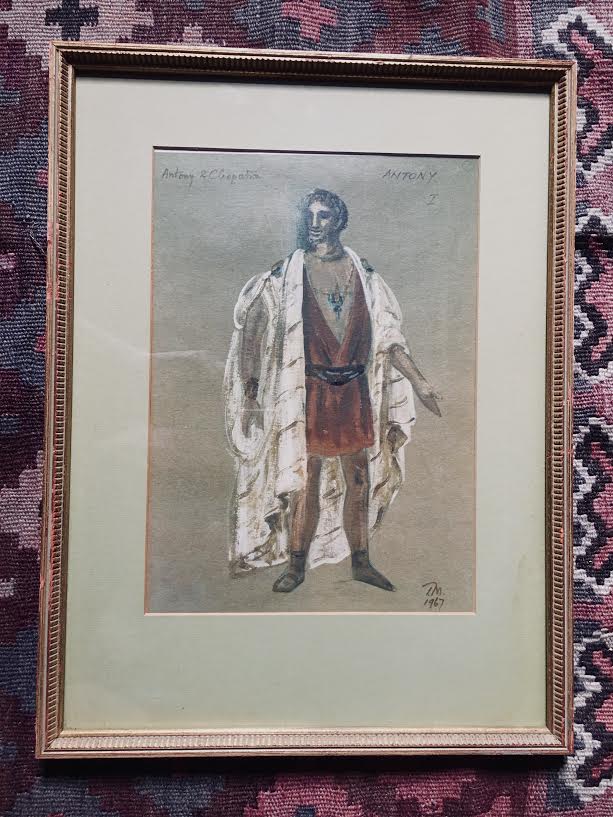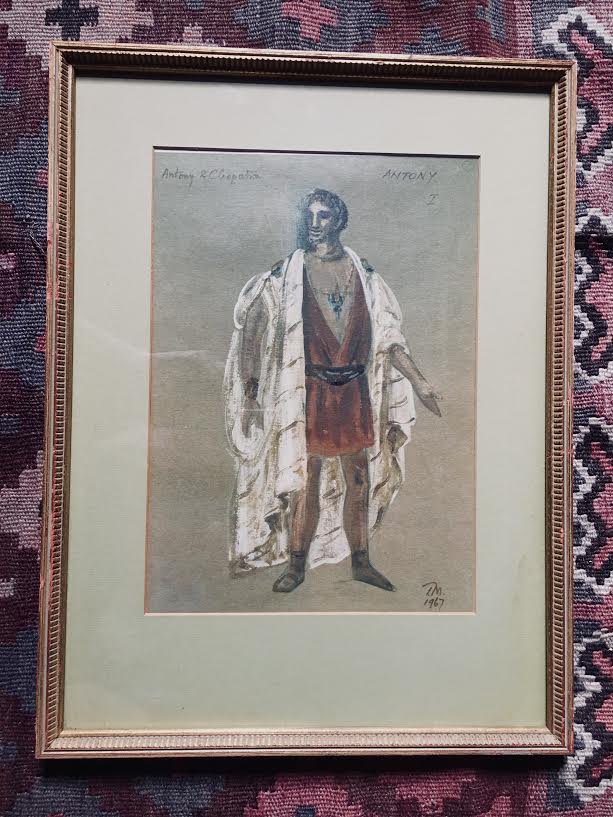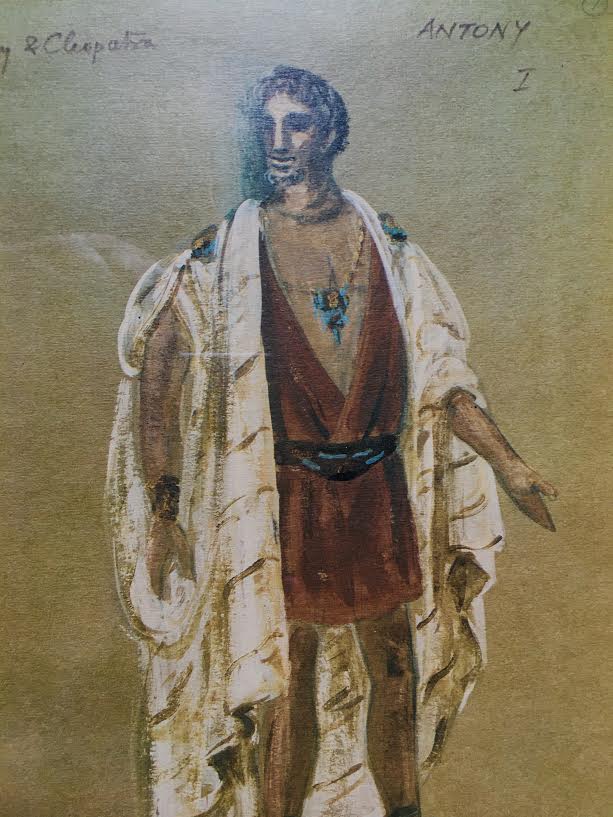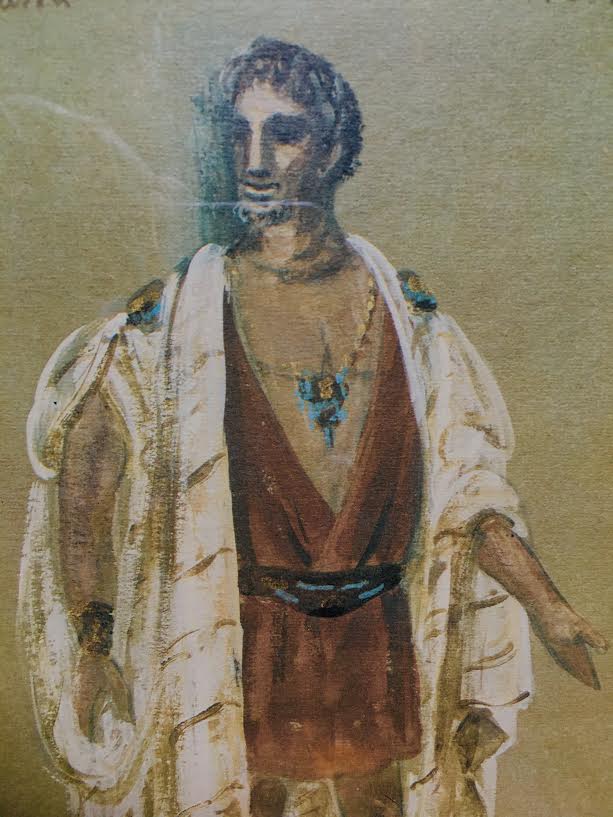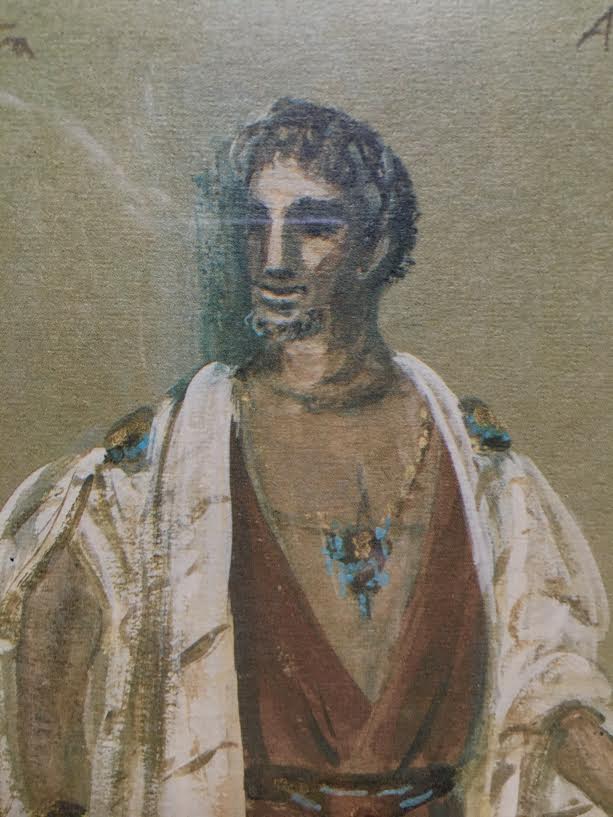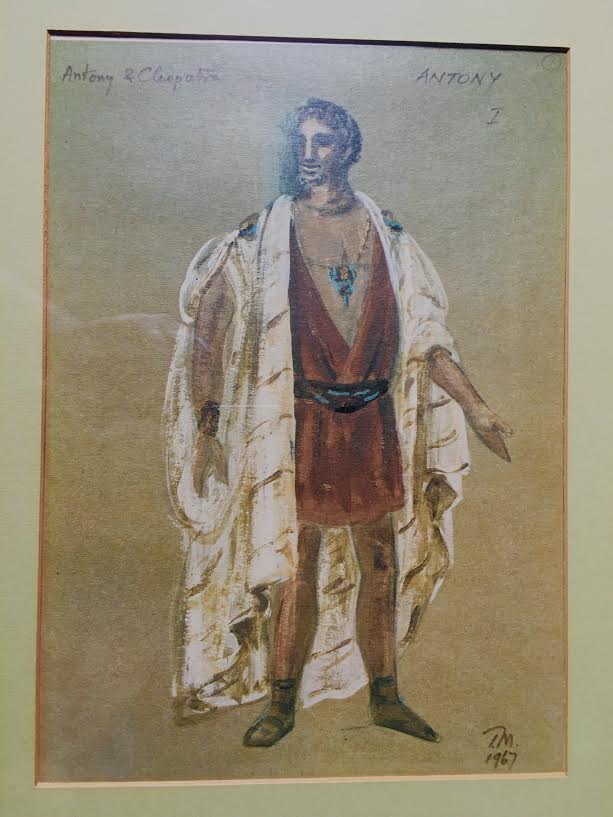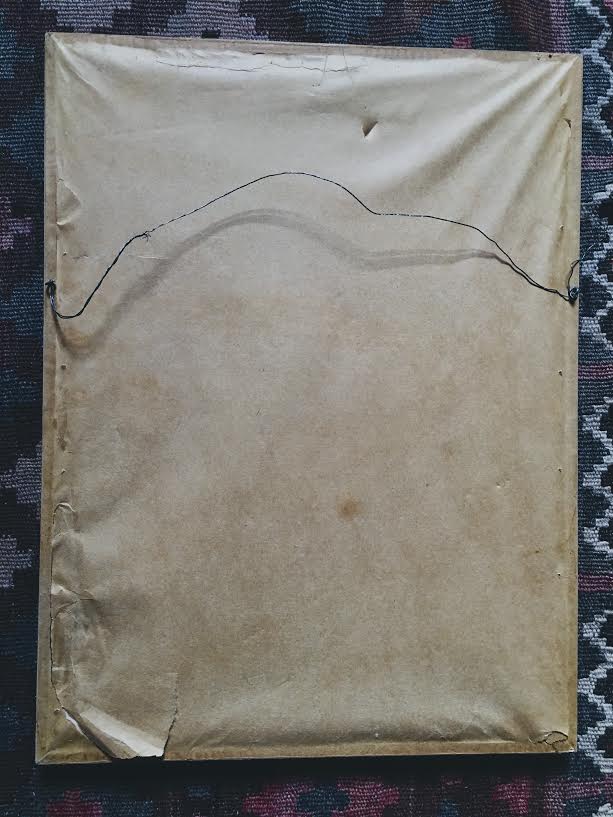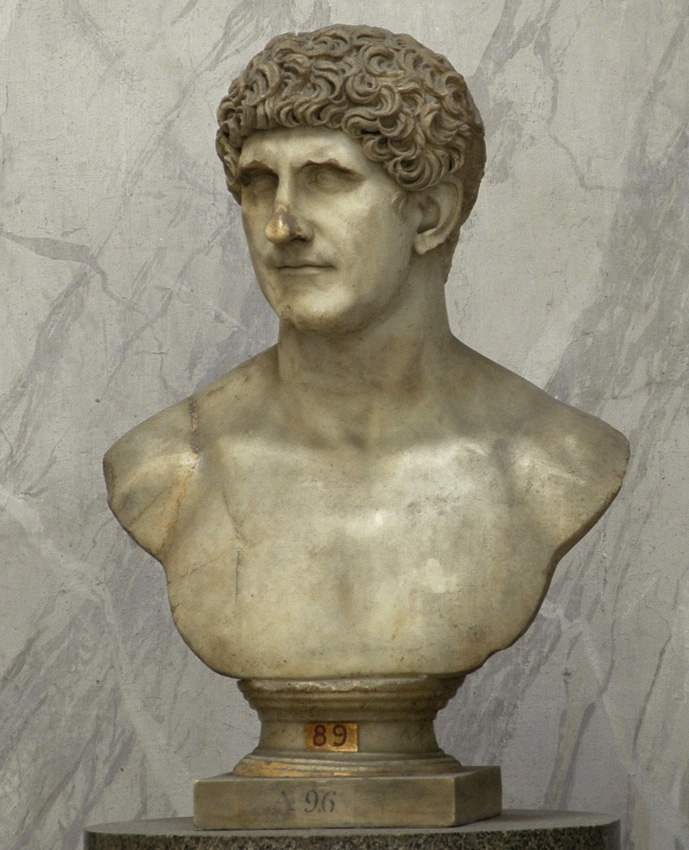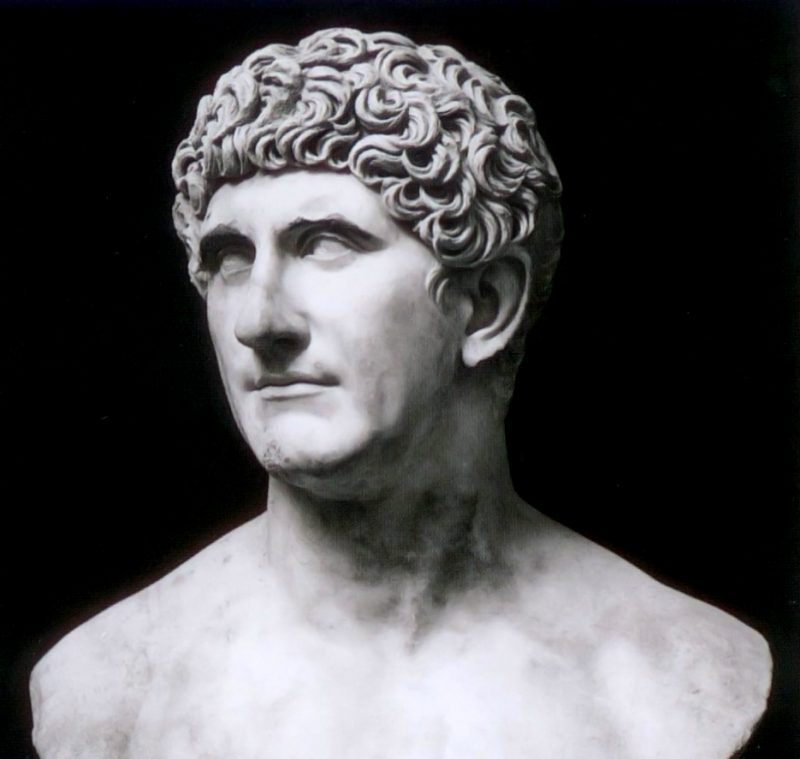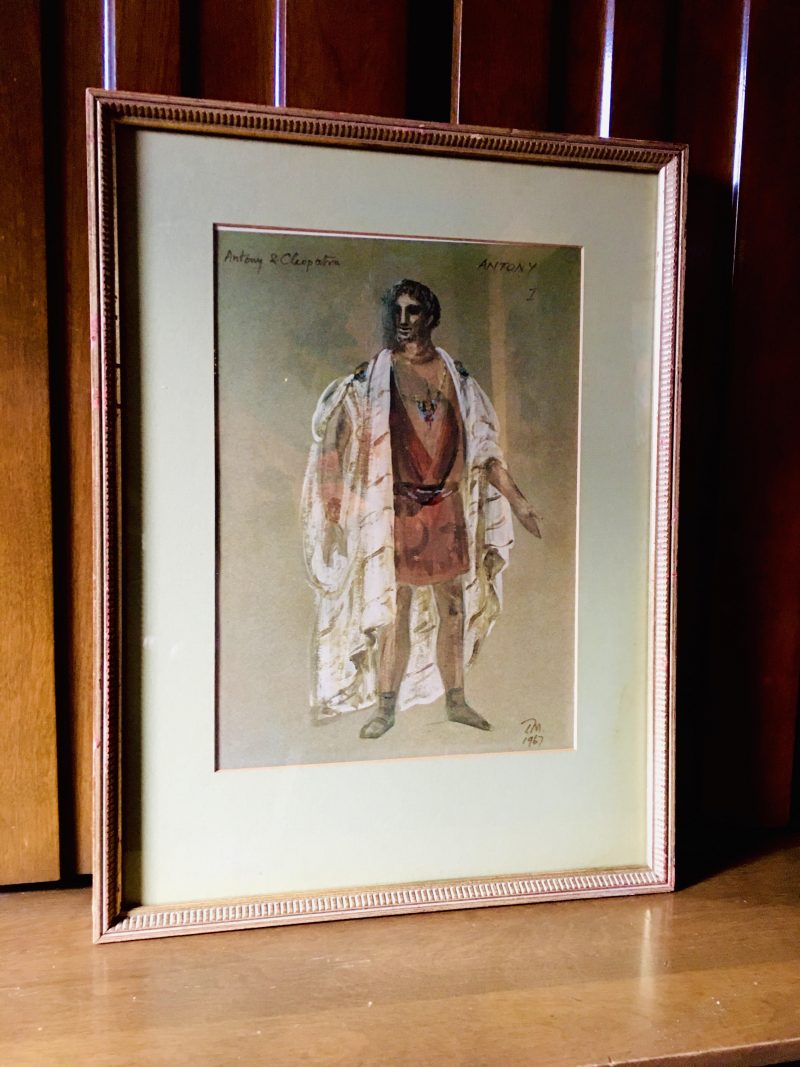SOLD. Portrait of Marcus Antonius (of Cleopatra) 1967
Framed portrait on paper of Anthony (Marcus Antonius) 1967. This image seems to be from a costume designer for theatre productions. Signed by hand & dated “T.M. 1967”. Costume design by Tanya Moiseiwitsch (“T.M.”) for Christopher Plummer in his role as Mark Anthony at the Stratford Festival in 1967. Titled by hand at top of image “Antony & Cleopatra” & “Antony I”. Item measures 7.75 inches width x 11 inches height. The frame measures 16 inches height x 12 inches width, & made of wood, detailed in gold trim, with a light olive colored mat. Some aging on the mat but overall in great condition.
SOLD. Asking $85
Last two images of sculptures of Marc Anthony are for reference only.
Further research:
This looks to be part of a portfolios of costume design prints sold at the Festival as souvenirs.
Information on the actual play this was designed for: https://internetshakespeare.uvic.ca/Theater/production/stage/3192/
MORE INFO: Cleopatra & Antony Published on 10 January 2011 Regarded by the Romans as “fatale monstrum”- a fatal omen, Cleopatra is one of the ancient world’s most popular, though elusive figures. The Egyptian Queen has been immortalized by numerous writers and film-makers, most popularly by Shakespeare in Antony and Cleopatra, and by Hollywood in Cleopatra (1963) starring Elizabeth Taylor and Richard Burton. The latter work features the memorable image of the enticing young Cleopatra emerging gracefully from an unfurled carpet in front of Roman general Julius Caesar. But is Cleopatra to be regarded merely as the lover of Julius Caesar and Mark Antony? Or did she play an important role not only in the history of Egypt, but also in that of the mighty Roman Republic?
Cleopatra VII Philopator (‘father-loving’) was born in January 69 BCE in the city of Alexandria, Egypt, the daughter of Ptolemy XII Auletes (117 BCE –51 BCE) and possibly Cleopatra V Tryphaena (c. 95 BCE – c. 57 BCE). Cleopatra was to become the last monarch of the Ptolemaic Empire (established in 323 BCE after the death of Alexander the Great), ruling Egypt from 51 BCE to 30 BCE. In 48 BCE Cleopatra had become an ally and lover of Julius Caesar and remained so until his assassination in Rome in March of 44 BCE. The death of Caesar threw Rome into turmoil, with various factions competing for control, the most important of these being the armies of Mark Antony (83 BCE– 30 BCE) and Octavian(63 BCE – 14 CE), the former a supporter and loyal friend Caesar, the latter his adopted son.
Cleopatra Meets Antony
In 41 BC Cleopatra was summoned to Tarsus (in modern southern Turkey) by Mark Antony. She is said to have entered the city by sailing up the Cydnus River in a decorated barge with purple sails, while dressed in the robes of the Greek goddess Aphrodite. Antony, who equated himself with the god Dionysus, the Greek god of wine, was instantly won over. Much like the meeting between Cleopatra and Caesar, both sides saw something in the other which they needed. For Cleopatra it was another opportunity to achieve power both in Egypt and in Rome, for Anthony the support of Rome’s largest and wealthiest client states in his campaign against the might of the Parthians (Parthia was a region in modern north-eastern Iran) was highly desirable. At the meeting Cleopatra allegedly requested that her half-sister Arsinoë, living in protection at the Temple of Artemis at Ephesus, be executed to prevent any future attempts on her throne. Anthony and Cleopatra soon became allies and lovers and he returned with her to Alexandria in 40 BCE.
In Alexandria Cleopatra and Antony formed a society of “inimitable livers”, which some historians have interpreted as an excuse to lead a life of debauchery, though it was more likely to have been a group dedicated to the cult of the mystical god Dionysus. In that year Cleopatra bore Antony the twins Alexander Helios (the Sun) and Cleopatra Selene (the Moon).
The Death of Cleopatra
After Antony’s death Cleopatra’s was taken to Octavian who informed her that she would be brought to Rome and paraded in the streets as part of his Triumph. Perhaps unable to bear the thought of this humiliation, on August 12, 30 BCE Cleopatra dressed in her royal robes and lay upon a golden couch with a diadem on her brow. According to tradition (found in ancient historian Plutarch, for example) she had an asp (an Egyptian cobra), brought to her concealed in a basket of figs, and died from the bite. Two of her female servants also died with her. The asp was a symbol of divine royalty to the Egyptians, so by allowing the asp to bite her, Cleopatra became immortal. Other historians (including Joyce Tyldesley) believe that Cleopatra used either a poisonous ointment or a vial of poison to commit suicide.
Cleopatra had lived thirty nine years, for twenty-two of which she had reigned as queen, and for fourteen she had been Antony’s partner in his empire. After her death her son Caesarion was declared pharaoh, but he was soon executed on Octavian’s orders. Her other children were sent to Rome to be raised by Antony’s wife, Octavia. Cleopatra represented the last significant threat to Roman authority and her death also marks the end of the Ptolemaic Kingdom. The vast treasures of Egypt were plundered by Octavian, and Egypt itself became a new Roman province. Within a few years the Senate named Octavian Augustusand he became the first Roman Emperor, consolidating the western and eastern halves of the Republic into a Roman Empire.
Recent archaeological work has cast some interesting but controversial light on the possible location of Cleopatra’s tomb. Greco–Roman historian Plutarch wrote that that Antony and Cleopatra were buried together, and, in 2008 CE archaeologists from the Egyptian Supreme Council of Antiquities and from the Dominican Republic, working at the Templeof Taposiris Magna, 28 miles west of Alexandria, reported that one of the chambers in the building probably contained the bodies of Cleopatra and Mark Antony. The team have so far discovered 22 bronze coins inscribed with Cleopatra’s name and bearing her image, a bust of Cleopatra, and an alabaster mask believed to represent Mark Antony. Work at the site is ongoing, and only time will tell if the archaeologist are correct in their theory that the great couple were interred at such a distance from Alexandria.
